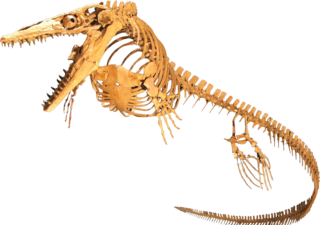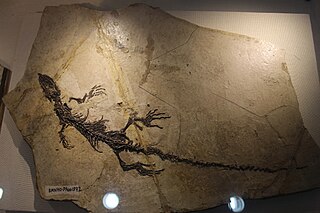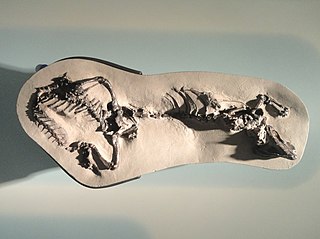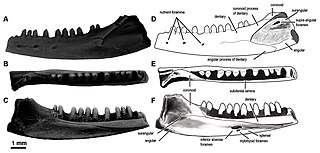The Cretaceous is a geological period that lasted from about 145 to 66 million years ago (Mya). It is the third and final period of the Mesozoic Era, as well as the longest. At around 79 million years, it is the longest geological period of the entire Phanerozoic. The name is derived from the Latin creta, "chalk", which is abundant in the latter half of the period. It is usually abbreviated K, for its German translation Kreide.

Mosasaurs comprise a group of extinct, large marine reptiles from the Late Cretaceous. Their first fossil remains were discovered in a limestone quarry at Maastricht on the Meuse in 1764. They belong to the order Squamata, which includes lizards and snakes.

Bactrosaurus is a genus of herbivorous hadrosauroid dinosaur that lived in Asia during the Late Cretaceous, about 96-85 million years ago. The position Bactrosaurus occupies in the Cretaceous makes it one of the earliest known hadrosauroids, and although it is not known from a full skeleton, Bactrosaurus is one of the best known of these early hadrosauroids, making its discovery a significant finding.

Chilantaisaurus is a genus of large theropod dinosaur, possibly a neovenatorid or a primitive coelurosaur, from the Late Cretaceous Ulansuhai Formation of China. The type species, C. tashuikouensis, was described by Hu in 1964.

Sonidosaurus is a genus of sauropod dinosaur from the Late Cretaceous. It was a titanosaur which lived in what is now Inner Mongolia. The type species, Sonidosaurus saihangaobiensis, was described by Xu, Zhang, Tan, Zhao, and Tan in 2006. It was a small titanosaur, about 9 meters (30 ft) long. It was found in the Iren Dabasu Formation; it was only slightly larger than the contemporaneous giant caenagnathid Gigantoraptor.

Nanshiungosaurus is a genus of therizinosaurid that lived in what is now Asia during the Late Cretaceous of South China. The type species, Nanshiungosaurus brevispinus, was first discovered in 1974 and described in 1979 by Dong Zhiming. It is represented by a single specimen preserving most of the cervical and dorsal vertebrae with the pelvis. A supposed and unlikely second species, "Nanshiungosaurus" bohlini, was found in 1992 and described in 1997. It is also represented by vertebrae but this species however, differs in geological age and lacks authentic characteristics compared to the type, making its affinity to the genus unsupported.

Yabeinosaurus is an extinct genus of lizard from the Early Cretaceous Jehol Group of northeastern China. The type species Yabeinosaurus tenuis is known from many well-preserved skeletons belonging to both juvenile and adult individuals. For about 60 years Yabeinosaurus was known only from juvenile specimens, leading scientists to believe that it was a small lizard with weakly developed bones. Because of this, it was thought to be closely related to geckos. Larger specimens up to 35 centimetres (14 in) snout‐vent length.

Luanchuanraptor is a genus of dromaeosaurid theropod dinosaurs from the Late Cretaceous of China. The genus is based on a partial skeleton from the Qiupa Formation in Luanchuan, Henan. They were medium-sized dromaeosaurids, the first Asian dromaeosaurid taxa described from outside the Gobi Desert or northeastern China.

Polyglyphanodontia, also known as the Borioteiioidea, is an extinct clade of lizards from the Cretaceous that includes around a dozen genera. Polyglyphanodontians were the dominant group of lizards in North America and Asia during the Late Cretaceous. Most polyglyphanodontians are Late Cretaceous in age, though the oldest one, Kuwajimalla kagaensis, is known from the Early Cretaceous Kuwajima Formation (Japan). Early Cretaceous South American taxon Tijubina, and possibly also Olindalacerta, might also fall within Polyglyphanodontia or be closely allied to the group, but if so, they would be two of only three Gondwanan examples of an otherwise Laurasian clade. They produced a remarkable range of forms. Chamopsiids, including Chamops, were characterized by large, blunt, crushing teeth, and were most likely omnivores. Macrocephalosaurus, from the Gobi Desert, was a specialized herbivore; it grew to roughly a meter long and had multicusped, leaf-shaped teeth like those of modern iguanas. Polyglyphanodon, from the Maastrichtian of Utah, was another herbivore, but its teeth formed a series of transverse blades, similar to those of Trilophosaurus. Peneteius had remarkable, multicusped teeth, similar to those of mammals. The polyglyphanodontids first appear in the latter part of the Early Cretaceous in North America, and became extinct during the Cretaceous-Paleogene extinction event. Polyglyphanodontians closely resembled the teiid lizards, and purported teiid lizards from the Late Cretaceous appear to be polyglyphanodontians. The only species known to have survived the Cretaceous was Chamops, which survived until the very early Ypresian.

The Qiupa Formation is a Late Cretaceous Maastrichtian geologic formation in Henan Province, central China. It is rich in dinosaur eggs and bones, such as those of carnivorous and herbivorous dinosaurs. The Qiupa Formation is considered to be Late Maastrichtian in age, about 72 million and 66 million years ago.

Ganzhousaurus is an extinct genus of oviraptorid dinosaur known from the Late Cretaceous Nanxiong Formation of Nankang County, Ganzhou City of Jiangxi Province, southern China. It was found in a Maastrichtian deposit and contains a single species, Ganzhousaurus nankangensis. It is distinguished by a combination of primitive and derived features.

Scincogekkonomorpha is a clade of lizards that includes scleroglossans and all lizards more closely related to scleroglossans than to iguanians. These "stem" scleroglossans include extinct lizards from the Late Jurassic and Early Cretaceous such as Bavarisaurus, Eichstaettisaurus, Liushusaurus, and Scandensia. Scincogekkonomorpha was named in 1961 and is now occasionally used as a stem-based taxon in contrast to the node-based taxon Scleroglossa. According to phylogenies based on morphological characteristics, Scincogekkonomorpha is the sister taxon of Iguania and together they make up crown group Squamata, the smallest clade including all living snakes and lizards.

Qianzhousaurus is a genus of tyrannosaurid dinosaurs that lived in Asia during the Late Cretaceous period. There is currently only one species named, the type species Qianzhousaurus sinensis which is a member of the tribe Alioramini within the group, and most closely related to Alioramus, another alioramin.
Priscagamidae is an extinct family of iguanian lizards known from the Late Cretaceous of Mongolia and China and the Eocene of India, spanning a range from 75 to 54 million years ago. It includes the genera Heterodontagama, Mimeosaurus, Phrynosomimus, Priscagama, and possibly Pleurodontagama. The first fossils of priscagamids were found in the Djadochta and Khermeen Tsav formations of Mongolia. More recently they have been found in the Cambay Formation in India, leading to the naming of Heterodontagama in 2013. Priscagamidae was originally described as a subfamily of Agamidae called Priscagaminae in 1984, but it was reclassified as a distinct family in 1989. Most phylogenetic analyses still find a close relationship between Priscagamidae and Agamidae, although a 2015 study found it to be basal to all other iguanian clades, warranting its removal from Iguania and placement in a larger clade called Iguanomorpha.
Saichangurvel is an extinct genus of iguanian lizards from the Late Cretaceous of Mongolia. It is a member of a clade called Gobiguania, an exclusively Late Cretaceous group of iguanian lizards that was likely endemic to the Gobi Desert. The type species, Saichangurvel davidsoni, was named by paleontologists Jack Conrad and Mark Norell of the American Museum of Natural History in 2007. It is known from a single nearly complete and fully articulated skeleton called IGM 3/858, which was found eroding from a block of sandstone during a thunderstorm at a fossil locality called Ukhaa Tolgod. IGM 3/858 comes from the Djadochta Formation, which is between 75 and 71 million years in age. Just as it is today, the Gobi was a desert during the Cretaceous. IGM 3/858 may have died in a collapsing sand dune, the rapid burial preserving its skeleton in pristine condition.
Anchaurosaurus is an extinct genus of iguanian lizard from the Late Cretaceous of Inner Mongolia, China. It belongs to an extinct clade of iguanians called Gobiguania that was endemic to the Gobi Desert during the Late Cretaceous. The type species, Anchaurosaurus gilmorei, was named in 1995 on the basis of a well-preserved skull and incomplete skeleton from the Djadochta Formation. Compared to other iguanians, Anchaurosaurus has a relatively elongated skull, large eye sockets, and higher tooth crowns. Phylogenetic analysis indicates that among gobiguanians, Anchaurosaurus is most closely related to Zapsosaurus from Mongolia. Below is a cladogram from Daza et al. (2012) showing the phylogenetic relationships of Anchaurosaurus:

Paramacellodidae is an extinct family of lizards that first appeared in the Middle Jurassic around 170 million years ago (Ma) and became extinct at the end of the Cretaceous around 66 Ma. It was one of the earliest groups of lizards to have undergone an evolutionary radiation, with members found across the supercontinent Laurasia. The phylogenetic relationships and constituent species of Paramacellodidae are uncertain. Many studies regard them to be scincomorphs, a large group that includes skinks and their closest extinct relatives, and possibly also to Cordyoidea, a group that includes spinytail lizards and relatives. Like modern skinks, paramacelloidids had rectangular bony plates called osteoderms covering most of their bodies, including their backs, undersides, and tails. They also had short and robust limbs. Paramacellodids are distinguished from other lizards by the combination two traits in their dentition, the teeth are labiolingually expanded at their bases, and the tooth apices are lingually concave.
Sinankylosaurus is a genus of dinosaur, originally described as an ankylosaur, from the late Cretaceous Period of Shandong, China. The genus contains a single species, Sinankylosaurus zhuchengensis, known from a nearly complete right ilium. The describers claim that the discovery of Sinankylosaurus further demonstrates the similarity between dinosaurs of eastern Asia and western North America.












